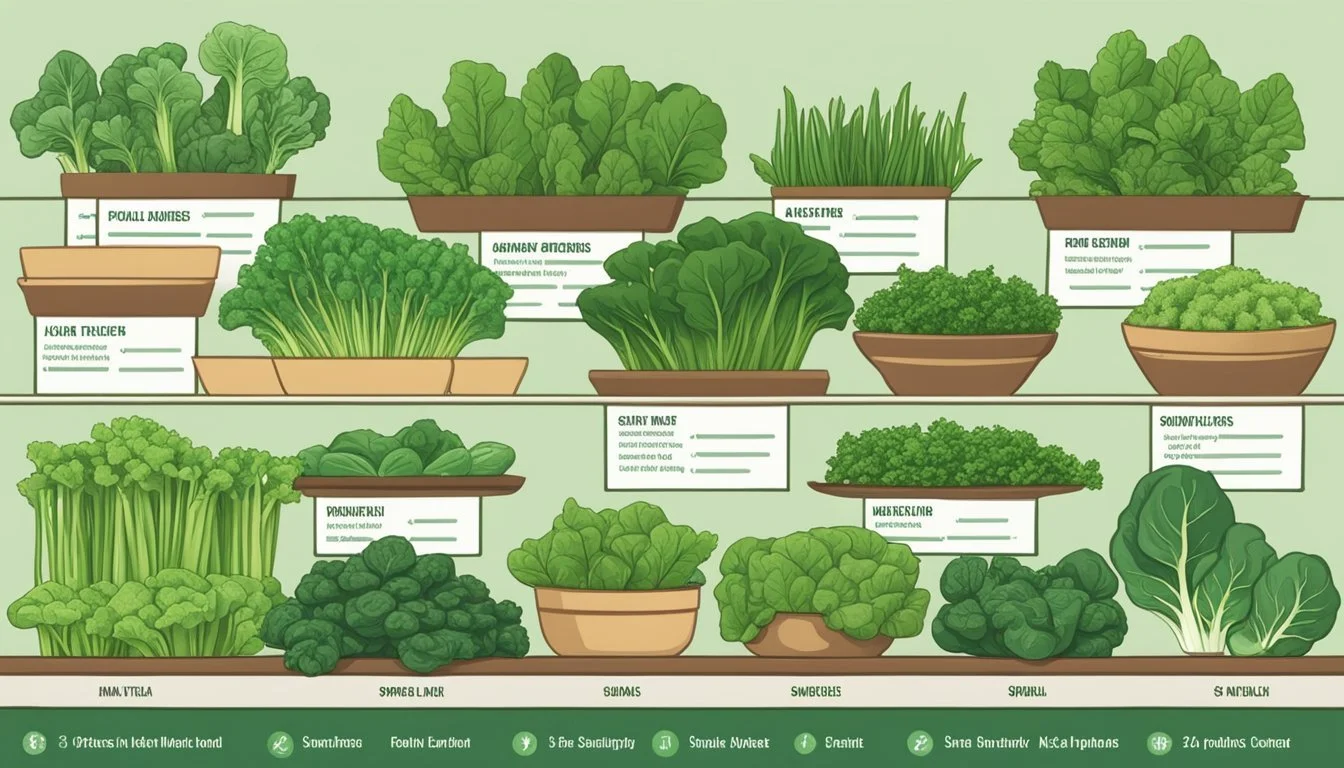Sorrel Substitutes
Top Alternatives for Cooking and Recipes
For those who love the unique tangy and citrusy notes of sorrel but find themselves without it, there are several excellent alternatives. Spinach, arugula, and mustard greens can replicate sorrel's flavors in your dishes. Spinach provides a mild earthiness, while arugula adds a slight bitterness, and mustard greens bring a peppery kick.
When tartness is essential, ingredients like lemon zest and sumac work wonderfully. They offer that critical acidity that sorrel imparts. Adding a splash of lemon juice or a sprinkle of sumac could be just the right touch to achieve the desired flavor profile in your recipes.
Beyond taste, it's worth noting that these substitutes also carry health benefits. Greens like spinach and arugula are packed with vitamins and minerals, ensuring your dishes remain nutritious. Whether you're preparing a salad or a comforting soup, these sorrel substitutes will keep your meals flavorful and healthy.
Understanding Sorrel
Sorrel, a vibrant green herb known for its distinctive tart taste, is commonly used in culinary dishes for both its flavor and nutritional benefits. However, it also has certain characteristics and potential risks that should be considered when incorporating it into meals.
Traits of Sorrel
Sorrel belongs to the Polygonaceae family. The leaves are typically green and can be either smooth or veined with red. They have a sharp, arrow-like shape and a crisp texture. A key feature of sorrel is its high oxalic acid content, which gives it a unique tartness. Oxalic acid can also contribute to its mildly astringent flavor.
Culinary Uses
Sorrel's tangy taste makes it a popular addition to various dishes. It is often used in soups, sauces, and salads. When cooked, it can be blended into creamy sauces or purees for a bright, acidic counterpoint. Sorrel pairs well with fish, poultry, and eggs due to its ability to cut through rich flavors. It also complements dairy-based dishes like cream soups and cheeses.
Health Benefits and Nutrients
Sorrel is rich in vitamins and minerals. It provides Vitamin C, which supports the immune system, and Vitamin A, important for vision and skin health. Potassium and Magnesium in sorrel help regulate blood pressure and muscle function. Additionally, sorrel is a source of antioxidants that combat oxidative stress and inflammation.
Potential Risks of Sorrel
While sorrel offers many health benefits, its high oxalic acid content poses certain risks. Excessive consumption can lead to the formation of kidney stones, particularly in individuals prone to oxalate accumulation. It may also interfere with calcium absorption, affecting bone health. Moderation is key to minimizing these potential toxic effects, and individuals with specific health conditions should consult a healthcare professional before consuming sorrel.
Sorrel's unique properties and varied applications make it a valuable herb in the culinary world, but it's essential to be mindful of its consumption.
Sorrel Taste Profile
Sorrel's flavor is distinguished by its notable tartness and a subtle blend of herbal and peppery notes. Each component contributes uniquely to this herb's distinctive taste.
Tartness and Acidity
Sorrel is especially recognized for its intense tartness and acidity. This tangy quality comes primarily from oxalic acid, which gives sorrel a sharp, almost lemon-like bite. Lemon juice is often used in culinary applications to replicate this aspect when sorrel is not available.
The acidity can be compared to a mild vinegar, offering a refreshing contrast in dishes. While the tartness stands out prominently in raw applications, such as salads, it mellows slightly when cooked, still imparting a zesty backbone to soups and sauces.
Herbal and Peppery Flavors
Alongside its tartness, sorrel exhibits unique herbal and peppery notes. The herbal aspect provides an earthy flavor that can remind one of a blend between spinach and parsley. This element is less intense than the acidity but adds a complex layer to the overall taste profile.
The peppery note is subtle, bringing a mild spiciness that complements the herb's fresh appeal. This combination of flavors makes sorrel versatile, enabling its use in a variety of culinary contexts from fresh greens in salads to a piquant component in more savory dishes.
Popular Sorrel Substitutes
Finding substitutes for sorrel can be essential for chefs and home cooks alike. Various greens and herbs can mimic its tartness, acidity, or peppery bite, each bringing unique qualities to the table.
Spinach as a Substitute
Spinach offers a versatile option for replacing sorrel, particularly in salads and cooked dishes. Its earthy flavor, combined with a subtle bitterness, can stand in for sorrel's unique profile. Adding a squeeze of lemon juice or a dash of vinegar to spinach can better replicate sorrel's acidity. Spinach is also widely available and easy to use, making it a convenient choice. Rich in iron and vitamins, it provides nutritional benefits similar to sorrel.
Arugula's Peppery Bite
Arugula is another excellent substitute for sorrel, known for its peppery bite and herbaceous flavor. It shares a slightly spicy, tangy taste that can bring a similar brightness to dishes. Arugula works well in raw preparations such as salads or as a garnish. This green is part of the Cruciferous family, which includes cabbage and broccoli, and introduces a delicate, slightly bitter element that pairs well with various ingredients.
Mustard Greens for a Spicy Kick
For those seeking a bolder alternative, mustard greens can serve as a competitive sorrel substitute. These greens are noted for their sharp, peppery flavor, which brings a spicy kick to dishes. Like sorrel, mustard greens are versatile and can be used in everything from salads to cooked dishes. They are rich in vitamins A, C, and K, contributing to their popularity in both culinary and nutritional contexts.
Rhubarb's Sourness
Rhubarb might seem unconventional, but its sourness makes it a surprisingly effective sorrel substitute. Though often associated with desserts, rhubarb stalks can also be used in savory dishes. The tart and tangy flavor of rhubarb can replace sorrel's sharpness in soups, sauces, and even salads. It offers a unique twist in flavor profiles and is quite versatile in various culinary applications.
Exotic and Regional Alternatives
Several exotic and regional alternatives can also be used as sorrel substitutes. Sumac, a tangy spice, can mimic sorrel's acidity when sprinkled over dishes. Tarragon adds a slight anise flavor, suitable for more nuanced substitutions. Lovage, with its celery-like taste, can provide a fresh, herbal note similar to sorrel. Each of these options offers distinctive flavors, allowing for creative adaptations in recipes needing sorrel's characteristic tang.
Substitutes in Cooking
When sorrel is not available, several substitutes can be used to achieve similar flavors and textures across various dishes. These substitutes can deliver the tart, earthy, or peppery notes that sorrel usually imparts.
For Salads and Dressings
Spinach can be an excellent replacement for sorrel in salads, providing a similar leafy texture. Though it lacks sorrel's characteristic tartness, adding a bit of lemon juice or vinegar can mimic the desired acidity. Sumac, a spice, offers a tartness that can be useful in dressings, adding a bright tang without altering the texture of greens. This makes it a well-suited ingredient for vinaigrettes and salad dressings.
In Soups and Stews
Rhubarb offers a unique tartness akin to sorrel and can withstand the cooking process involved in soups and stews. It's an unexpected but effective option typically associated with sweet dishes. Mustard Greens bring a peppery, savory flavor which works well in heartier dishes like stews, giving a robust kick that sorrel would provide. These substitutes enhance the flavor profile without drastically changing the texture.
Adding Flavor to Meat and Egg Dishes
For meat dishes, tamarind paste can offer the tartness sorrel provides. It pairs well with rich flavors, adding a tangy depth to meats. Red currants are another option, their vibrant tartness enhancing sauces and glazes for both meat and egg dishes. Similarly, finely chopped mustard greens or spinach can add a subtle bitterness and earthy undertones, complementing the richness of these dishes.
Modifying Pastas and Casseroles
Mustard Greens and spinach can both be used to replace sorrel in pasta dishes and casseroles. They provide similar textures and can be cooked into sauces. The addition of a bit of lemon zest or juice can emulate the tartness of sorrel. Rhubarb, though unconventional, can be finely chopped and cooked into casseroles, offering a different but effective source of tartness and mild sweetness. This can balance richer ingredients in dishes, providing a well-rounded flavor profile.
Gardening and Shopping Tips
Learn how to grow your own alternatives to sorrel and find the best options available at grocery stores. Both methods have their own perks and make this versatile substitute more accessible.
Growing Your Sorrel Alternatives
Growing your own sorrel alternatives such as arugula, spinach, and rhubarb can be both rewarding and economical. Arugula thrives in cooler weather and can be easily grown in a garden bed or containers. It prefers well-drained soil and partial shade.
Spinach, another excellent substitute, grows best in temperatures between 50-70°F. It's crucial to keep the soil moist and provide adequate sunlight. Spinach can be harvested in as little as 6 weeks from planting.
Rhubarb, with its tangy flavor, is a perennial plant that requires more space. It prefers full sun and well-drained soil. Note that only the stalks are edible; the leaves are toxic.
Finding Substitutes at the Grocery Store
When shopping for sorrel substitutes at the grocery store, look for fresh arugula, spinach, and rhubarb in the produce section. Arugula should have small, delicate leaves and a peppery aroma. Opt for organic options if possible to avoid pesticide residues.
Spinach leaves should be vibrant green without any yellowing or wilting. They can be found in pre-packaged bags or as loose leaves in the produce section. Check for freshness by feeling the leaves; they should be crisp, not slimy.
Rhubarb stalks, distinguishable by their bright pink color, are often found near the celery. Ensure the stalks are firm and free from blemishes. Avoid any with soft spots or discoloration.
These tips will help in both growing and selecting the best alternatives for sorrel, ensuring you always have a suitable option on hand.
Nutritional Comparison
When considering substitutes for sorrel, it's important to compare their nutritional profiles. This includes evaluating the minerals, vitamins, and dietary fibers present in these greens, as well as their iron and calcium content.
Minerals in Green Vegetables
Green vegetables like spinach, arugula, and mustard greens offer various minerals. Spinach is rich in magnesium, which aids in muscle and nerve function. Arugula contains potassium, crucial for heart health and maintaining fluid balance. Mustard greens provide zinc, essential for immune function and DNA synthesis. These greens often have lower sodium levels, beneficial for blood pressure control.
Vitamins and Dietary Fiber
Green vegetables are excellent sources of vitamins and dietary fiber. Spinach and arugula are high in Vitamin K, crucial for blood clotting and bone health. Vitamin C is abundant in mustard greens, supporting the immune system and skin health. Dietary fiber found in these vegetables helps with digestion and can reduce the risk of kidney stones by preventing the formation of oxalates.
Nutritive Chart:
Vegetable Vitamin K (mcg/100g) Vitamin C (mg/100g) Dietary Fiber (g/100g) Spinach 483 28.1 2.2 Arugula 108.6 15 1.6 Mustard Greens 257.5 70 2.8
Iron and Calcium Content
Iron and calcium are crucial for various bodily functions. Spinach is noted for its high iron content, assisting in oxygen transport and energy metabolism, though the presence of oxalates can inhibit iron absorption. Comparatively, arugula and mustard greens also provide iron but to a lesser extent.
Calcium is abundant in both spinach and mustard greens. This mineral supports bone health and muscle function. Arugula offers calcium too, albeit in smaller quantities. These green vegetables are beneficial, but for those prone to kidney stones, moderation is suggested due to the oxalate content in spinach and mustard greens.
Iron and Calcium Table:
Vegetable Iron (mg/100g) Calcium (mg/100g) Spinach 2.7 99 Arugula 1.5 32 Mustard Greens 1.6 115
Conclusion
Sorrel substitutes can provide similar tartness and mouth-watering flavor in cooking. Spinach makes an excellent alternative, especially in salads, when combined with lemon juice or vinegar to mimic sorrel’s acidity.
Arugula offers a peppery and slightly bitter taste, adding complexity to dishes. Mustard greens are another notable substitute, known for their peppery and savory flavors, matching sorrel’s versatility.
For those looking for unique options, sumac can be a great choice. Although it's a spice and not a leaf, its tart quality can enhance various recipes. Greek yogurt brings richness and health benefits, making it a nutritious choice in sauces, dips, and dressings.
Common Sorrel Substitutes
Spinach
Arugula
Mustard Greens
Sumac
Greek Yogurt
Each substitute not only offers a unique flavor profile but also different health benefits and visual appeal. Understanding these options allows for more creativity in the kitchen.
When sorrel is unavailable, utilizing these alternatives ensures that your dishes remain flavorful and exciting.







